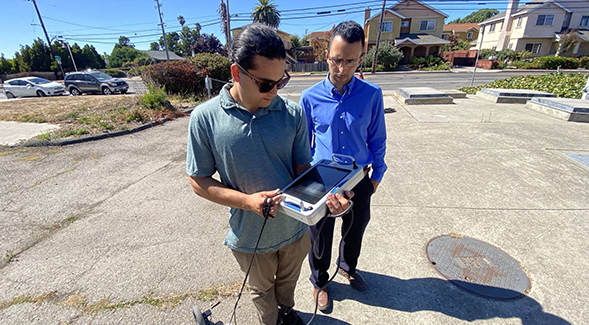Sea Level Rise Imperils South San Diego County Sewers
SDSU engineers tackle the impact of climate change on sewer systems in Imperial Beach and other underserved coastal communities.

Sewage overflows from Tijuana have been contaminating Imperial Beach for many decades. The problem recently reached crisis levels, with city leaders calling on the state and federal governments for more funds to fix the aging sewage infrastructure on both sides of the border.
By causing sea levels to rise, climate change also plays a role in compromising the sewage infrastructure of Imperial Beach, according to a new study in the journal Sustainable Cities and Society. Led by Yousef Sangsefidi (Ph.D., engineering ‘23), San Diego State University researchers teamed up with scientists from Scripps Institution of Oceanography to examine how rising sea levels impact sewer pipes in the city and what this means for the future.
“When sea level is rising, it also shifts the groundwater table up,” said Hassan Davani, associate professor of civil, construction and environmental engineering and principal investigator of the study. Groundwater is the water that lies beneath the surface of the Earth.
Sewer infrastructure is designed to sit above the groundwater table, but sea level rise causes it to fall below that level, subjecting it to subsurface flooding. “That means that if there is a hole or a crack in the system, we get additional inflows, and in areas like Imperial Beach, we see lots and lots of those inflows,” said Davani.
Davani said such inflows increase loading on the infrastructure, and eventually cause sewer overflows, which exacerbate the environmental impacts of sewage spills in the Tijuana-Imperial Beach region.
Sewer pipes are made from vitrified clay, which resists corrosion from wastewater. But the material does not handle stress and strain as smoothly as metal or reinforced concrete pipes, said Davani. The pipes are designed to be in place for 50 years, but those in Imperial Beach are much older in some areas, making them even more vulnerable to cracking.
“They have more cracks and holes in the pipes,” said Davani. So these are all opportunities for the shallow groundwater to disrupt the system.”
The researchers installed four monitoring wells in Imperial Beach to measure groundwater levels and develop a high-resolution 3D model to predict the future impact of sea level rise on the sewer infrastructure.
“We can shift the sea level up and see how the groundwater is going to change with it across the city,” said Davani.
Davani says most studies have focused on the impact of sea level rise on beaches, buildings and other above-ground assets, but this is the first of its kind to look at its impact below the surface.
The researchers found that more than a third of the length of sewer pipes in Imperial Beach are vulnerable to penetration from groundwater, and the problem is likely to worsen.
“By mid-century, we're talking about a big portion of the pipe network being impacted, and that means a lot of additional volume to the wastewater infrastructure.”
This could add millions of dollars to the cost of operating the sewer system in Imperial Beach every year. The study also revealed that even sewer infrastructure miles to the east of Imperial Beach can be compromised by rising sea levels.

The study was funded by the National Science Foundation. In January, Davani received a five-year NSF CAREER Award that will allow his team to expand on the research.
They plan to use artificial intelligence tools to analyze large stretches of sewer pipe recorded with closed-circuit television cameras.
“We want to understand all these areas in a pipe, because every crack and every hole means additional inflow to the system with the sea level rise,” said Davani.
Davani’s graduate student, Kian Bagheri — who is pursuing a Ph.D. in the joint doctoral program in engineering through SDSU and University of California San Diego — set up a camera at YMCA Camp Surf in Imperial Beach to record timelapse images of the street below to analyze how storm events drain to certain areas. He hopes to replicate the system in other parts of the community for flood detection.
“Ultimately, the goal is to help the city and the community alleviate some of their flooding issues,” said Bagheri.
Collaborating with community members is an important aspect of the work, “so that our engineering solutions are being informed by what the community actually is willing to do,” Bagheri added.
Bagheri and the team conducted social surveys in collaboration with Megan Welsh Carroll, an associate professor in the School of Public Affairs, to assess the willingness of Imperial Beach residents to adopt practices that reduce flooding, such as using rain barrels to collect excess water or support the creation of green spaces with permeable surfaces for drainage.
Davani says there are no quick fixes in Imperial Beach, but they hope their work can help guide the city toward a more resilient underground infrastructure over time.
Climate change is a global problem, and Davani and colleagues are working with other low-lying, underserved coastal communities in San Francisco’s southeastern district and San Leandro in northern California, and in Bremerton, WA. What they learn could provide valuable lessons in climate resilience for low-lying coastal communities around the world.



